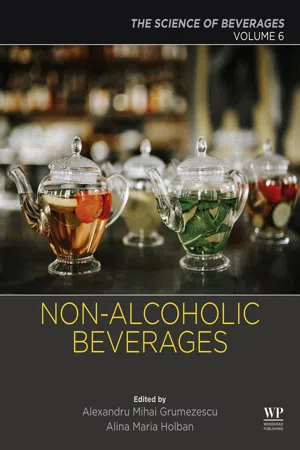
Non-alcoholic Beverages
Volume 6. The Science of Beverages
- 559 pages
- English
- ePUB (mobile friendly)
- Available on iOS & Android
About this book
Nonalcoholic Beverages, Volume Six in The Science of Beverages series, offers a wide-range of knowledge and expertise from research professionals around the world. The book focuses on the research and development of innovative products and new growing trends based on consumer demand for natural drinks that have health benefits. The book discusses the properties and benefits of developing nonalcoholic beverages, their production particularities, associated properties, physiochemical characteristics, and methods to help researchers and students learn about utilized nonalcoholic beverages.- Presents a broad scope of topics and process solutions from experts in the beverages industry- Covers the latest technologies and microbiological methods that enhance the health benefits of beverages- Includes emerging trends in nonalcoholic beverages and offers a variety of safety and quality techniques for adding value to products
Frequently asked questions
- Essential is ideal for learners and professionals who enjoy exploring a wide range of subjects. Access the Essential Library with 800,000+ trusted titles and best-sellers across business, personal growth, and the humanities. Includes unlimited reading time and Standard Read Aloud voice.
- Complete: Perfect for advanced learners and researchers needing full, unrestricted access. Unlock 1.4M+ books across hundreds of subjects, including academic and specialized titles. The Complete Plan also includes advanced features like Premium Read Aloud and Research Assistant.
Please note we cannot support devices running on iOS 13 and Android 7 or earlier. Learn more about using the app.
Information
Tea, the “Ambrosia” Beverage: Biochemical, Cellular, Molecular, and Clinical Evidences
† Department of Health Sciences, University of Mauritius, Réduit, Republic of Mauritius
Abstract
Keywords
1.1 Introduction

1.2 Bioactive Components of Tea
Table of contents
- Cover image
- Title page
- Table of Contents
- Copyright
- Contributors
- Series Preface
- Preface
- 1: Tea, the “Ambrosia” Beverage: Biochemical, Cellular, Molecular, and Clinical Evidences
- 2: Essential Element Contents of Turkish Black Tea
- 3: Functional Nonalcoholic Beverages: A Global Trend Toward a Healthy Life
- 4: Hawk Tea, a Traditional and Healthy Natural Beverage in South China
- 5: Development of Mixed Beverages Based on Tropical Fruits
- 6: Tuba, a Fermented and Refreshing Beverage From Coconut Palm Sap
- 7: Kefir-Type Drinks From Whey
- 8: Physiochemical Characteristics Nutritional Properties and Health Benefits of Sugarcane Juice
- 9: Engineering and Biomedical Effects of Commercial Juices of Berries, Cherries, and Pomegranates With High Polyphenol Content
- 10: Kombucha: A Promising Functional Beverage Prepared From Tea
- 11: Engineered Soybean-Based Beverages and Their Impact on Human Health
- 12: Engineering and Health Benefits of Fruits and Vegetables Beverages
- 13: Kinetics of Phytochemicals Degradation During Thermal Processing of Fruits Beverages
- 14: Toxicological Aspects of Ingredients Used in Nonalcoholic Beverages
- 15: Functional and Traditional Nonalcoholic Beverages in Turkey
- Index